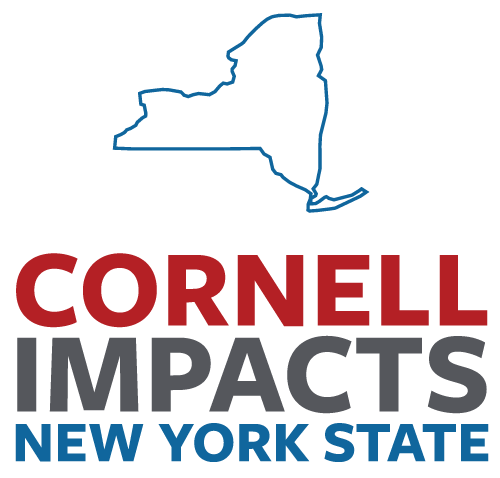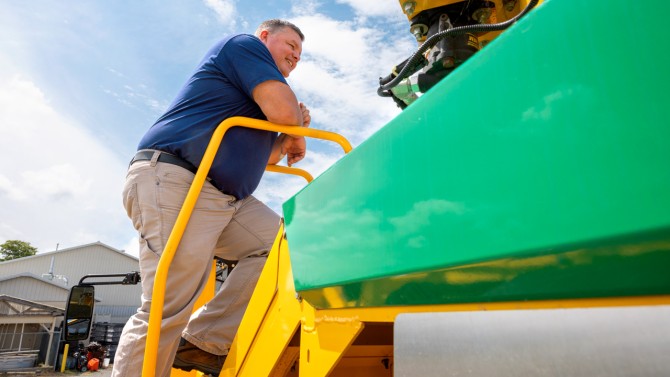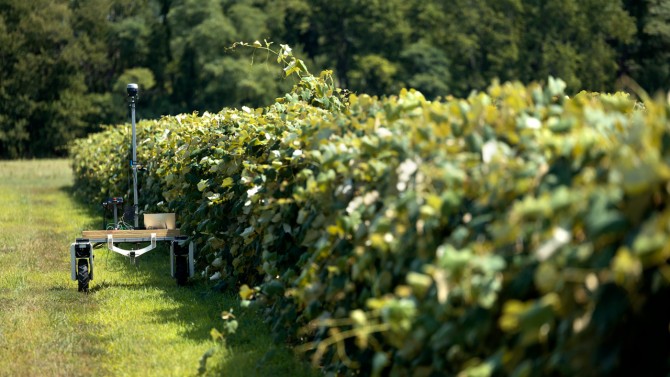On a tranquil stretch of Cornell's experimental vineyard in Portland, New York, the hum of sensors and whirring of drones overhead signal a new era of agriculture. Here, at the Cornell Lake Erie Research and Extension Laboratory (CLEREL), the vineyard is becoming the university's first living laboratory of precision, autonomy and sustainability, supporting the grape industry in New York and Pennsylvania.
"There is a lot of environmental variation on a farm," said Terry Bates, director of CLEREL. "But it used to be you'd set machines at a particular rate and just go, a 'one-size-fits-all' approach. We've started to get into precision viticulture, using ag sensors, soil sensors and canopy sensors in order to spatially map the variability in the vineyard."
The farm draws from a new kind of digital toolkit. At the heart of this transformation is Efficient Vineyard (MyEV), a free, web-based platform developed by Bates and software designer Nick Gunner, the founder of Orbitist who started a doctoral program in Yu Jiang's lab in 2024. MyEV, funded through the U.S. Department of Agriculture, turns complex spatial data into clear, actionable maps. Growers can sketch their farm layouts, import data from special sensors or just their smartphones, clean and visualize the data, and transform it into management "prescription maps" to treat their crops at variable rates.
Terry Bates, director of the Cornell Lake Erie Research and Extension Laboratory, works at the experimental vineyard in Portland, New York.
With MyEV, traditional vineyard tasks are guided by data rather than guesswork. Farmers can now, from their desktops or phones, flag spots needing more or less fertilizer, identify pruning needs, and map block-level differences in their crops with surgical precision.
"MyEV does five things," Bates said. "It imports data, cleans it up, interpolates it and makes a map, translates the map into a viticulture information map and then uses that in a prescription for vineyard management. I'm building tools for growers."
The goal of this new project, according to Bates, is to make it easy for growers to adopt precision viticulture. The team aims to reach that goal by improving the base platform that is free to use while completing the development of a more complex web-based spatial data platform for growers that may adopt a subscription model, demonstrating the value of precision viticulture through research field trials and providing experiential learning activities for producers to implement in their own operations.
At its core, the new technology employs sensors that speak the vine's language. For example, after a late-April freeze last year, Bates conducted a scan and paired it with field validation via the mobile mapping app data collector. This combination enabled him to accurately map freeze damage and predict fruit cluster counts across blocks.
Many area vineyards set too large of a crop this year in response to the freeze last year, Bates said, and these predictive tools enable variable-rate fruit thinning to bring vineyards back into balance. In Concord grape blocks, data from normalized difference vegetation index (NDVI) mapping guided stratified sampling and informed a variable-rate thinning prescription. Mechanical harvesters adjusted shaking intensity block by block. The result? Balanced vines, with just the right relationship between leaves and fruit to optimize fruit quality this year and improve yields for next year.
Next, Bates is turning his attention to the big issue of dormant grapevine pruning, which is labor intensive and represents over one quarter of vineyard production costs: "The goal of our multi-disciplinary team is to integrate our current technologies in vineyard mechanization with autonomous tool carriers and robotic pruning arms to tackle a complex and expensive production practice."
A number of other faculty members lend multidisciplinary muscle to Bates's precision agriculture vision, enabling a broader ecosystem of innovation.
Leading efforts to integrate robotics and AI into vineyard management, Yu Jiang, assistant professor in the School of Integrative Plant Science, Horticulture Section at Cornell AgriTech, showcases autonomous platforms like the PhytoPatholoBot (PPB) robots designed to patrol vineyards, capture high-resolution physiological data and power next-day decisions. He envisions a "swarm" of autonomous vehicles that move through vineyards, leaf by leaf, gathering data that was once painstakingly collected by hand.
PhytoPatholoBot patrols vineyards, capturing high-resolution physiological data to power next-day decisions.
Katie Gold, assistant professor and Susan Eckert Lynch Faculty Fellow in the School of Integrative Plant Science, Plant Pathology and Plant-Microbe Biology Section at Cornell AgriTech, is pioneering early disease detection through hyperspectral imaging - gathering data with no plant disturbance.
Her lab maps subtle physiological changes in grapevines, from asymptomatic disease markers to responses to management interventions, scaling from ground rovers to spacecraft imagery. Most recently, high-resolution hyperspectral flights captured by NASA's AVIRIS-3 (a set of instruments deployed on an airplane, as opposed to ground based, drone, or satellite deployed sensors), are yielding advanced maps of canopy chemistry, water health and disease risk.
And tackling the age-old problem of weeds with 21st-century tools, Lynn Sosnoskie, assistant professor in the School of Integrative Plant Science, Horticulture Section at Cornell AgriTech, conducts research that explores robot-mounted electric weeders and vision-guided sprayers - mechanisms that precisely zap or suppress weeds with far fewer chemicals and less soil disruption.
Data-driven precision through frost mapping and variable thinning, autonomous robots for real-time vineyard analytics, early disease detection and precision weed control: Bates envisions a future where such tools on farms aren't exceptions but the norm, places where tradition and technology walk the rows together, one informed step at a time.
"Ag technology is developing very quickly and has huge potential to transform vineyard operations across New York and the country," Bates said. "However, choosing which tech is right for an operation can be overwhelming and expensive. Resources like the new CLEREL Tech vineyard and MyEV are intended to evaluate solutions under real production conditions."









